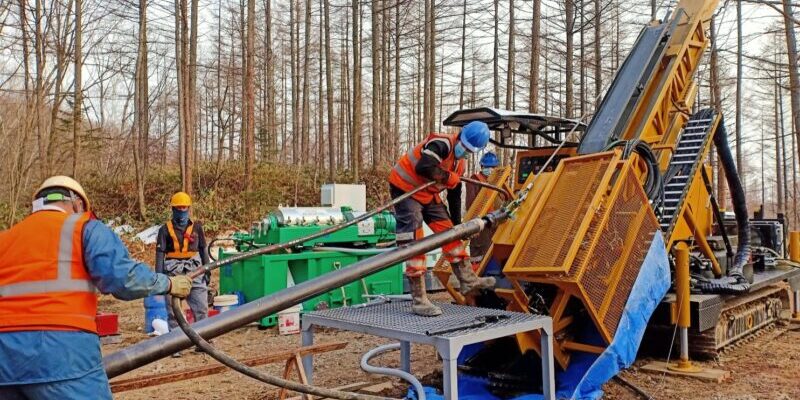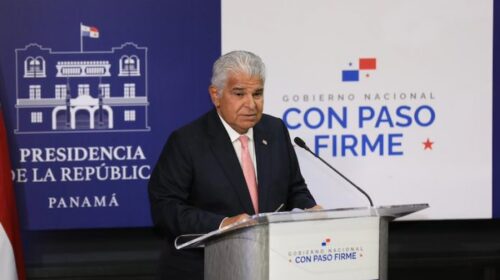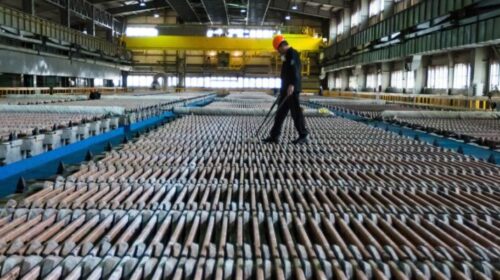BEMETALS REPORTS FURTHER POSITIVE COPPER INTERVALS FROM 2023
BeMetals Corp. (TSXV: BMET, OTCQB: BMTLF, Frankfurt: 1OI.F) (the “Company” or “BeMetals”) is has announced the remaining drilling results from its 2023 exploration program at the Pangeni Copper Project in Zambia (the “Project” or the “Property”).
A new phase of core drilling has recently commenced to identify additional zones of higher-grade copper and expand the footprint of the mineralization within the priority D-Prospect area.
Highlights:
.D14-C1: Returned multiple zones of copper mineralization from a shallow, approximately 70 metres, vertical depth
.D14-C1: Interval 1: 69.41 metres grading 0.25 % copper (“Cu”), including: 12.91 metres grading 0.37% Cu, and Interval 2: including 12.64 metres grading 0.32% Cu with 7.64 metres grading 0.39% Cu
.The mineralization, and associated alteration discovered at the D-Prospect, currently traced over 1.5 kilometres along strike, shows many of the hallmarks of large-scale copper deposits mined in the Domes Region of the Zambian Copperbelt
.A follow up core drilling program is underway to test extensions and grade continuity of the hole D22-C1 (Interval 3: 18.10 metres grading 0.70% Cu) intercept reported in January 2024, and other drilled copper intersections at this Prospect, beneath the shallow Kalahari sand cover
Note: Table 1 below provides details of these 2023 drilling program results and other intersections in drill hole D14-C1.
John Wilton, President and CEO of BeMetals, stated “We are pleased with the analytical results indicating multiple, or stacked, zones of copper mineralization from drill hole D14-C1 that was drilled during last year’s exploration program.
These new D14-C1 and recently released D22-C1 drill hole results re-enforce the large-scale discovery potential of the priority D-Prospect at the Pangeni Project.
In February, Dr. Richard Sillitoe completed a drill core review of the D-Prospect and concluded that the copper mineralization is closely similar in geological setting, style, and age to that exploited by Barrick Gold Corporation at their Lumwana Copper Mine, in the Zambian Copperbelt, and the current results motivate further drilling.
The Company has recently commenced a planned 1,800 to 2,000 metre follow-up core drilling program and approximately 600 metres of this program have already been drilled with the first completed drill hole under sampling and dispatch to the laboratory. First results from the current drilling are expected during Q2, 2024.
We are increasingly encouraged and excited by what we are seeing from our ongoing drilling of the D-Prospect at the Pangeni Project in Zambia.
The Project is delivering compelling results, indicating significant scale potential of the copper mineralization beneath the Kalahari sand cover.
These technical results are importantly enhanced by the pedigree of the Zambian Copperbelt, the backdrop of increasing copper mining and exploration investments into Zambia, and the strong fundamentals for the copper price.”
PANGENI COPPER PROJECT: D-PROSPECT
Complete results have now been received from the 2023 drilling campaign at the D-Prospect which comprised 2,032 metres of shallow aircore drilling to test for additional bedrock copper anomalies below the Kalahari sand cover, and 787 metres of follow-up core drilling in three holes (D22-C1, D14-C1, D11-C1).
These new results from drill hole D14-C1 further enhance the potential of the D-prospect, in context with the previously reported zones of mineralization from holes D22-C1 and D2-C1, including 18.10 metres grading 0.70% and 14.05 metres grading 0.37% copper respectively (see Figure 1).
The D14-C1 results importantly include interval 1, a broad zone of 69.41 metres, from a vertical depth of approximately 70 metres, grading 0.25% copper that includes multiple higher-grade zones ranging from 3.5 to 12.91 metres width at copper grades from 0.35% to 0.48% copper (see Figure 2 and Table 1).
This new data demonstrates that extensive zones of lower grade material envelop the multiple, or stacked, zones of higher-grade copper mineralization similar to what is seen at both the Sentinel and Lumwana copper mines in the Domes Region of Zambia, where cut-off grades of 0.13% (1) and 0.16% (2) copper are applied.
Interval 2 includes additional zones of mineralization with 12.64 metres grading 0.32% copper that includes 7.64 metres grading 0.39% copper (see Figure 2 and Table 1).
The copper mineralization in D14-C1 is dominantly chalcopyrite, and overall, a zonation with an increase in bornite, a higher tenor copper mineral, has been observed towards the southwest of the D-Prospect from drill holes D14-C1, D2-C1 and D22-C1.
As noted by Dr. Richard Sillitoe, the D-Prospect mineralization is closely similar in geological setting, style, and age to that exploited by Barrick Gold Corporation at their Lumwana Copper Mine, farther east in the Domes region (see Figure 3).
The Lumwana Mine with Mineral Reserves of 538.8 million tonnes grading 0.56% Cu (2)) and First Quantum Minerals Ltd.’s Sentinel Mine with Mineral Reserves of 792.4 million tonnes grading 0.46% Cu (1) (see locations in Figure 3) are also within the Domes Region of the Zambian Copperbelt.
The deposits of these mines are sediment hosted copper style, generally shallowly dipping and/or plunging tabular bodies, with the alteration mineral kyanite associated with the copper mineralization, similar to our current observations and interpretation of the D-Prospect.
At the Lumwana mine the thickness of the ore schist units at its Malundwe deposit is 15 metres (3), and the average thicknesses of the upper, central, and lower ore schist units at its Chimiwungo deposit are 10, 60 and 12 metres, respectively (3) generally the same to current widths of the mineralized zones at the Company’s D-Prospect.
Drill hole D11-C1 did not intersect any significant zones of copper mineralization and is currently interpreted to have been drilled into the footwall units below the main target zone as intersected in drill hole D22-C1.
The Company has commenced a planned 1,800 to 2,000 metre, follow-up, phase of core drilling to test initially for extensions of the copper mineralization to the southwest of the 2023 drilling at the D-Prospect area of the Property. The Company will release new drilling results during Q2 and Q3 2024 as they become available.
The Pangeni Project copper mineralization, is a westerly extension of the Zambian Copperbelt and is concealed under a relatively thin but extensive layer of Kalahari sand cover.
The open pit Sentinel Copper Mine, operated by First Quantum Minerals, is located approximately 130 kilometres northeast of the Pangeni Project and currently represents the westernmost copper mine of the Domes Region within the prolific Zambian Copperbelt.
The Pangeni Project is pro rata funded by BeMetals (72.2%) and the Japan Organization for Metals and Energy Security (“JOGMEC”) (27.8%).
The Project team includes optionees Copper Cross Zambia Limited (“CCZ”) and Pangeni Mineral Resources Limited (“PMRL”) the licence holders and community relations managers.
(1) First Quantum Minerals Ltd. website, Mineral Reserves – as at December 31, 2022, and reported based on a long-term $3.00/lb Cu price. The current depleted in-pit Mineral Reserve as at December 31, 2022 for Sentinel.
(2) Barrick Gold Corporation website, Mineral Reserves – December 31, 2013, Technical Report on the Lumwana Mine, North-Western Province, Republic of Zambia, Barrick Gold Corporation, Report for NI 43-101, March 27, 2014.
(3) Bernau, R., Roberts, S., Richards, M., Nisbet, B., Boyce, A., Nowecki, J. (2013) The geology and geochemistry of the Lumwana Cu (± Co ± U) deposits, NW Zambia. Mineralium Deposita, 48:137–153.
Figure 1: Pangeni Copper Project: D-Prospect: 2023 Drilling Program: D14-C1, D11-C1, and D22-C1 Results, Plan Map with Previous Core Drill Holes, and Combined Phases of Shallow Air Core Results
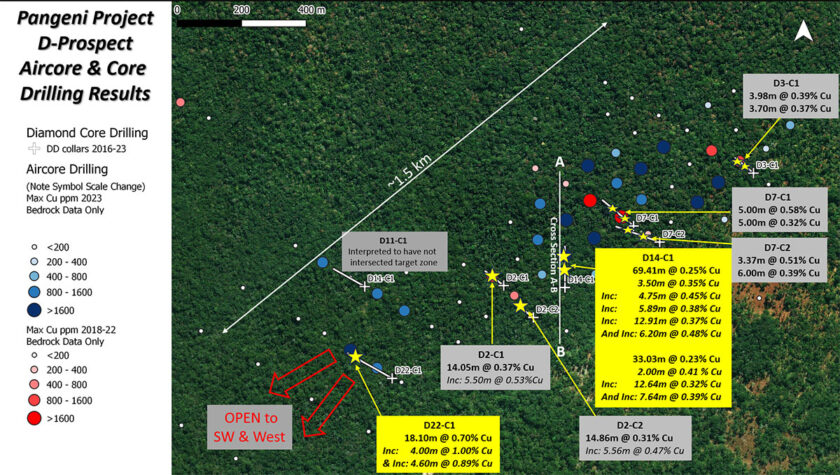
Note: D14-C1, and D11-C1 results reported here (See Tables 1 & 2). Other drill hole results previously reported in BeMetals’ news releases: BeMetals Delivers Significant Copper Intersection at Pangeni Project in Zambia and Announces Closing of $2 Million Convertible Debenture , dated January 9, 2024, BeMetals Reports Encouraging Core Drilling Results from Pangeni Copper Exploration Project in Zambia, dated October 16, 2019, BeMetals Returns Further Positive Drilling Results from Pangeni Copper Project, dated April 14, 2021, and BeMetals Intersects Further Encouraging Copper Results from Pangeni Exploration Project in Zambia, dated January 25, 2022.
Figure 2: 2023 Drill Program: Simplified Cross Section Through Drill Hole D14-C1 (Looking East)
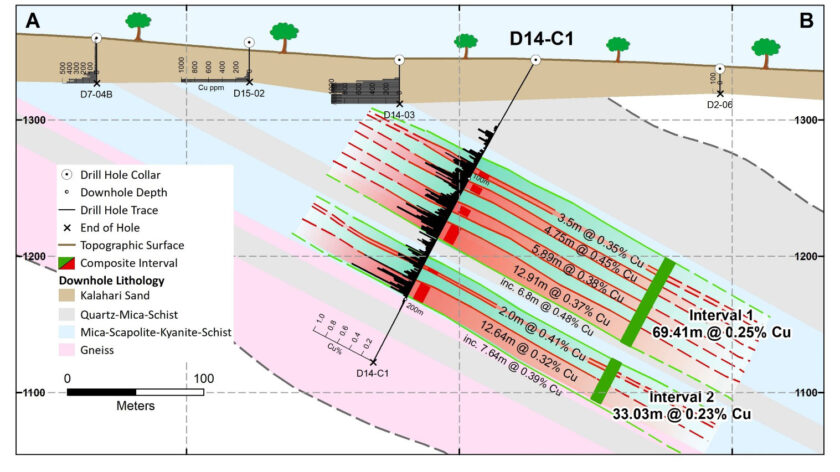
Table 1: 2023 Drill Program: D-Prospect: D14-C1 Drill Hole Intersection Results
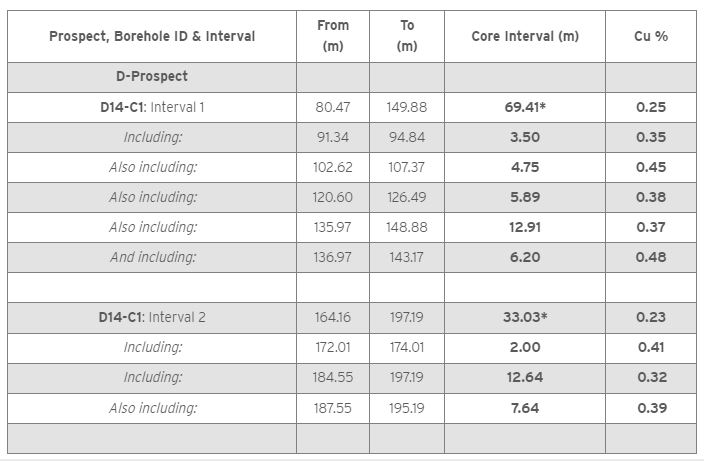
able 1 Notes: Intertek Genalysis completed the analytical work with the core samples processed at their preparation facility in Kitwe, Zambia.
All analytical procedures were conducted in an Intertek Genalysis laboratory in Perth, Australia. Reported widths are drilled core lengths as true widths are unknown at this time.
Based upon current data it is estimated true widths range between 80 and 90% of the drilled intersections. A nominal cut-off grade of 0.25% Cu has been used to determine the boundaries of these intersections with no more than 3.0 metres of internal dilution of the intercepts. *
A nominal cut-off grade of 0.1% Cu has been used to determine the boundaries of these intersections with no more than 9.20 metres of internal dilution of the intercept.
PANGENI COPPER PROJECT: OTHER TARGETS
In addition to the work conducted at the D-Prospect during the 2023 exploration program, 2,972 metres of shallow aircore, and 1,100 metres of core drilling were completed to test other exploration targets on the Property.
These targets are located between 10 to 20 kilometres away from the priority D-Prospect. Figure 4 indicates the locations of these targets, the aircore lines completed and core drill hole collar positions.
Results from these targets indicate and confirm that there are multiple zones and geological settings with a high degree of exploration potential within the Property.
Target Q3 was outlined by three anomalous aircore holes (Q3-05A, Q3-05 and Q3-05B) completed during the 2022 exploration program that returned bedrock copper values of 859, 331 and 210 parts per million (ppm) copper respectively.
The follow-up core hole Q3-C3 intersected a zone of 2.61 metres grading 0.49% copper (see Table 2). While a relatively narrow interval, its significance is increased by its host lithologies currently interpreted as Katangan units, and this target being located some 2 kilometres due east of the SW Target (see Figure 4). Future exploration in this area would include expanding of the aircore testing coverage at the Q3 Target.
At the P4 Target, core hole P4-C1 returned an interval of 5.00 metres grading 0.40% copper including 2.39 metres grading 0.71% copper.
The host lithologies appear to be basement units and copper oxide minerals were observed in these zones. Further interpretation will be completed to decide if further priority exploration is motivated in this target area.
At the L and Q Targets, drill holes L4-C1, L4-C2 and Q5-C1 did not intersect any significant copper mineralization. Table 3 shows the drill hole ID, azimuth, dip, end of hole depth, collar coordinates and status of all the core drill holes from the 2023 program.
Figure 3: Map Showing Selected Large Scale Copper Mines in Zambia and DRC with the Domes Region of Zambia

Figure 4: Pangeni Copper Project: 2023 Drilling Program: L4-C1/C2, P4-C1, Q5-C1 and Q3-C3 Results, Plan Map with Core Drill Holes, and Shallow Air Core Line Locations
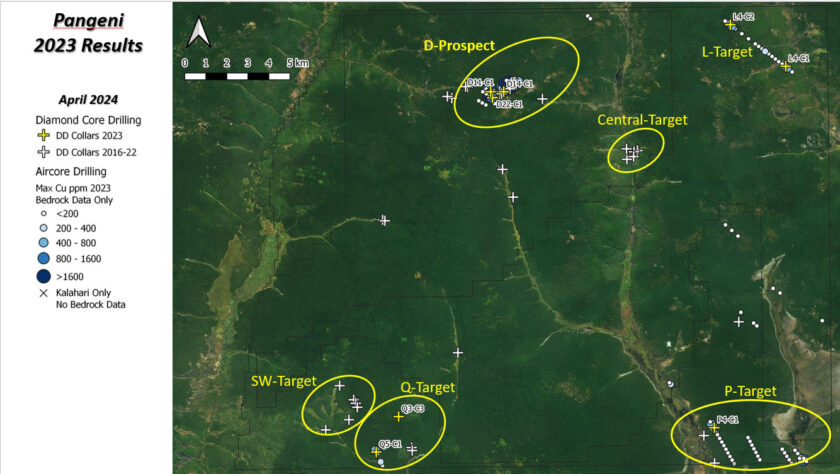
Table 2: 2023 Drill Program: Q3-C3 and P4-C1 Drill Hole Intersection Results

Table 2 Notes: Analytical work as above for Table 1, and reported widths are drilled core lengths as true widths are unknown at this time.
Based upon current data it is estimated true widths range between 85 and 90% of the drilled intersections. A nominal cut-off grade of 0.1% Cu has been used to determine the boundaries of these intersections with no internal dilution of the intercepts. * Oxide copper observed.
Table 3: Pangeni Project: 2023 Program: Drill Hole ID, Azimuth, Dip, End of Hole Depth and Collar Coordinates
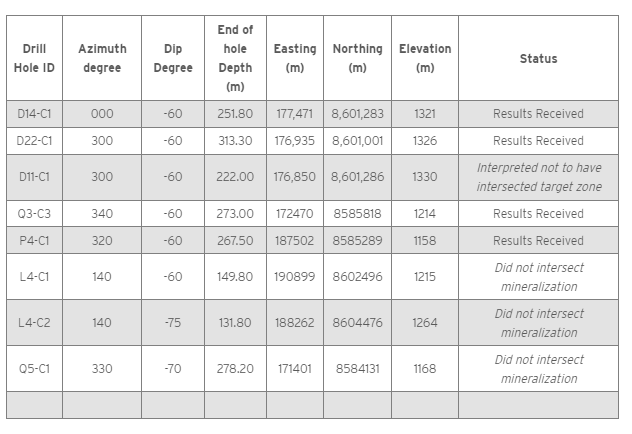
QUALITY ASSURANCE AND QUALITY CONTROL
The results reported here for this core drilling program were analyzed by Intertek Genalysis, an independent and accredited laboratory. Samples were prepared at their facility in Kitwe, Zambia and analytical work conducted in Perth, Australia.
The results were determined using multi-acid, near total digest, and analyzed by Inductively Coupled Plasma (“ICP”) Optical (Atomic) Emission Spectrometry (“OES”).
The core sampling was conducted with a robust sampling protocol that included the appropriate insertion of standard reference material, duplicates and blanks into the sample stream.
Field operations and management have been provided by Remote Exploration Services (“RES”) an independent geological consulting and contracting company. The core drilling was conducted by BluRock Mining (Drilling) Services of Kitwe, Zambia.
KAZAN GOLD PROJECT: OPERATIONAL UPDATE
In November 2023, the Company completed a very modest initial phase of drilling which included 449 metres of scout core drilling in two holes at the Todoroki Gold-Silver Project in Hokkaido, Japan (“Todoroki”).
The results from this initial phase of Todoroki drilling have been received. Drill hole TK23-02 intersected three shallow, quartz and quartz-carbonate veins grading 0.08, 0.48 and 0.32 grams per tonne (“g/t”) gold, associated with 26.9, 33.2 and 3.3 g/t silver respectively.
Future drill targets at Todoroki will be designed to intersect at deeper levels within interpreted extensions of the historical Todoroki Mine vein system.
The Company is also working on generating additional drill targets at its Kazan Gold portfolio of five gold projects in Japan.
Table 4: Kazan Gold: Todoroki Gold Project: TK23-02 Drill Hole Results

Table 4 Notes: Intertek Testing Services completed the analytical work with the core samples processed at their accredited laboratory in Manila, Philippines (See details in QA/QA section below).
Reported widths are drilled core lengths as true widths are unknown at this time. Based upon current data it is estimated true widths range between 55 to 65% of the drilled intersections.
For the mineralized intervals a nominal cut-off grade of 0.1 g/t Au has been used to determine the boundaries of the intersections with no internal dilution of the intercept.
Table 5: Kazan Gold: Todoroki Project TK23-01 and TK23-02: Drill Hole ID, Azimuth, Dip, End of Hole Depth and Collar Coordinates

QUALITY ASSURANCE AND QUALITY CONTROL
The new results reported here for this core drilling program were analyzed by Intertek Testing Services, an independent and accredited laboratory.
Samples were prepared and analytical work conducted in Manila, Philippines. The results were obtained using the following analytical methods as appropriate to determine the gold grades; FA50N/AA of 50g fire assay, with Atomic Absorption Spectrometry (“AAS”) finish and FA50GR/GR of 50g fire assay with Gravimetric finish for over limit samples exceeding 10 g/t Au.
The core sampling was conducted with a robust sampling protocol that included the appropriate insertion of standard reference material, duplicates, and blanks into the sample stream.
Field operations and management have been conducted by BeMetals’ personnel. The core drilling was conducted by Energold Drilling.
![]()


